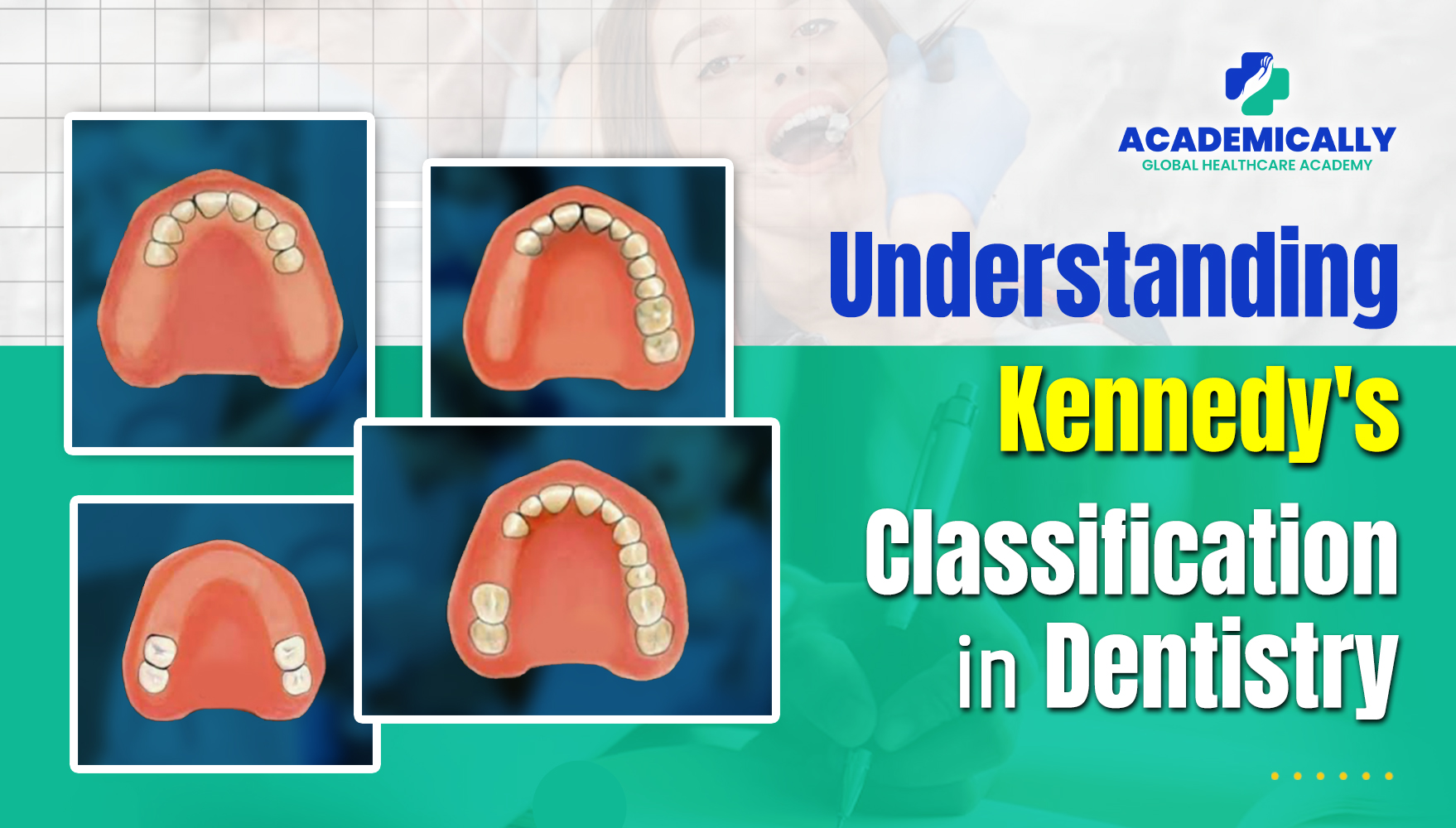Before we move any further, it is important first to learn the key terms that will form the foundation for understanding Kennedy's Classification and its application in Prosthodontics:
- Partial Edentulism: Refers to the condition where a patient is missing one or more teeth but still retains some natural teeth. It's a common dental issue that requires professional help to restore both function and aesthetics.
- Prosthodontics: This specialised branch of dentistry is dedicated to restoring and replacing teeth. Prosthodontists are to design and fit various dental prostheses, such as dentures, bridges, and implants, enhancing oral health and appearance.
- Partial Dentures: These are removable dental appliances designed to replace missing teeth. They are customised based on Kennedy's Classification and address specific patterns of partial edentulism, giving patients functional and natural-looking replacements.
The Four Classes of Kennedy's Classification
Kennedy’s Classification, developed to categorise partial edentulism (missing teeth), consists of FOUR distinct classes. Each class provides a systematic way to identify the location and extent of tooth loss. Understanding these classes helps dentists create treatment plans to address their patients' specific needs and conditions.
Class I
Class I includes bilateral edentulous areas that are located posterior to the remaining natural teeth. This means there are no natural teeth on either side at the back of the dental arch.
Example: Missing molars and premolars on the dental arch's left and right sides.
Considerations: Designing a removable partial denture (RPD) for Class I requires significant support from the remaining anterior teeth to distribute the forces effectively during chewing. Additional stability features like major connectors and indirect retainers may be needed to ensure the denture does not shift or rotate. The lack of posterior teeth can make achieving stability and retention more challenging, necessitating careful planning and possibly using precision attachments or implants for added support.
Class II
Class II consists of a unilateral edentulous area that is located posterior to the remaining natural teeth. This means that one side of the dental arch has no natural teeth at the back.
Example: The right side of the dental arch has missing molars and premolars, while the left side retains all teeth.
Considerations: In Class II cases, the design must balance the forces on the edentulous side to prevent tilting and undue stress on the remaining teeth. A stronger framework might be necessary to ensure stability and prevent the denture from tipping or rotating during function. Clasps and indirect retainers are critical to enhance retention and support, and the design may incorporate stress-breakers or flexible connectors to accommodate the unilateral distribution of forces.
Class III
Class III features a unilateral edentulous area with natural teeth remaining both anterior and posterior to it. This type of edentulous space is bounded by natural teeth on either side.
Example: There is a single gap on the left side of the dental arch, with natural teeth both in front of and behind the gap.
Considerations: Designing an RPD for Class III is generally more manageable due to the natural tooth support on both sides of the gap. This support provides excellent stability and retention, reducing the risk of denture movement. The design can be simplified with conventional clasp assemblies and may not require additional features for stability. The natural teeth adjacent to the edentulous area help distribute forces evenly.
Class IV
Class IV is characterised by a single but bilateral (crossing the midline) edentulous area located anterior to the remaining natural teeth. This type involves the loss of front teeth.
Example: Missing central and lateral incisors, crossing the midline, while the canines and posterior teeth remain intact.
Considerations: Aesthetic concerns are more significant in Class IV cases due to the visibility of the missing teeth. Thorough planning is required to ensure a natural appearance and proper function. The design must incorporate esthetic elements such as lifelike prosthetic teeth and natural-looking gum tissue. Stability and retention are also essential and could be achieved by using clasps, precision attachments, or even dental implants. The goal is to create a restoration that blends with the patient's natural teeth, providing both cosmetic satisfaction and functionality.
Each class in Kennedy's Classification has its challenges and needs special attention to the patient's needs. By understanding each class, dentists can create practical and attractive partial dentures that improve their patient's oral health and quality of life.
Applegate's Modifications to Kennedy's Classification
In the 1960s, Applegate made important updates to Kennedy's Classification to make it more accurate and useful for dentists. These changes, known as Class V and VI, help dentists better categorise missing teeth, allowing them to create more effective and personalised treatment plans for their patients.
Class V
Class V involves areas in the front of the mouth where teeth are missing, but there are no additional spaces without teeth, called modification spaces. This class is typically used when the missing teeth are bounded by natural teeth on both sides, but the front tooth that should support the denture isn't suitable for support. Class V resembles a Class III situation with the key difference being that the front tooth cannot be used for any support.
Example: A single missing tooth in the front with no additional missing teeth elsewhere in the dental arch.
Considerations: The focus is on aesthetic restoration and maintaining the natural appearance of the smile. Designing an RPD for Class V often involves paying more attention to the prosthetic teeth' colour, shape, and alignment to ensure they blend well with the remaining natural teeth.
Class VI
Class VI includes situations where all teeth are present, but some teeth need to be replaced due to other issues such as severe decay or trauma.
Example: A dental arch where all teeth are present, but one or more teeth are non-functional and need to be replaced.
Considerations: The emphasis is on preserving the dental arch's integrity while replacing the problematic teeth. The design needs to ensure the functionality and appearance of the replacement teeth match the natural ones as closely as possible.
Importance in Dental Practice
Kennedy's Classification provides a systematic approach for dentists to evaluate and address partial edentulism correctly. It ensures that dental professionals diagnose, plan treatments, and communicate consistently. It also helps predict how well the dental prosthesis will work and the overall oral health outcomes for the patient.
Benefits of Understanding Kennedy's Classification
- Enhanced Treatment Planning: Helps in designing functional and aesthetic RPDs.
- Improved Patient Outcomes: Ensures that the prosthesis fits and functions correctly, improving patient satisfaction.
- Effective Communication: Standardised terminology promotes clear communication among dental professionals and laboratories.
Conclusion
Kennedy's Classification is one of the most essential classification systems used in restorative dentistry. It guides dental professionals in creating effective and patient-specific treatment plans for Partial Edentulism. By understanding and applying this Classification, dentists can improve the functionality, aesthetics, and longevity of removable partial dentures, ultimately enhancing patient care and satisfaction.

Choosing the right coaching impacts your understanding of basic dental concepts like Kennedy's Classification. Academically offers comprehensive courses tailored for the Australian Dental Council (ADC) exam, ensuring you perform well in your exams. Our platform provides expert guidance, flexible learning schedules, and supportive mentors to help you succeed. Visit Academically to learn more about becoming a certified dental professional in Australia or New Zealand.



